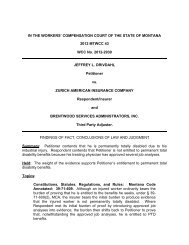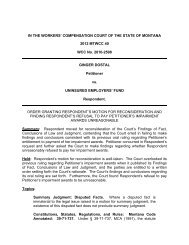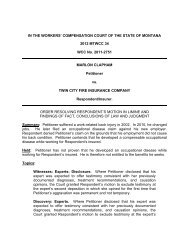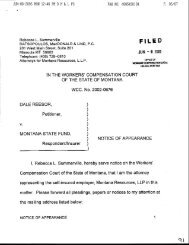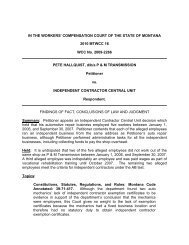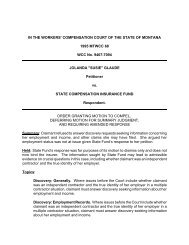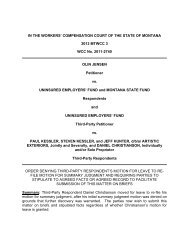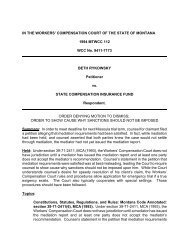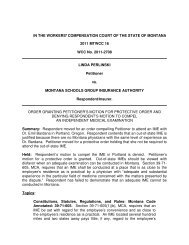order dismissing without prejudice - Workers' Compensation Court
order dismissing without prejudice - Workers' Compensation Court
order dismissing without prejudice - Workers' Compensation Court
You also want an ePaper? Increase the reach of your titles
YUMPU automatically turns print PDFs into web optimized ePapers that Google loves.
IN THE WORKERS' COMPENSATION COURT OF THE STATE OF MONTANA<br />
1994 MTWCC 114<br />
WCC No. 9202-6375<br />
JOSEPH McCRACKEN<br />
Petitioner<br />
vs.<br />
CITY OF GREAT FALLS<br />
Respondent/Employer<br />
DEPARTMENT OF LABOR & INDUSTRY<br />
Intervenor.<br />
ORDER DISMISSING PETITION WITHOUT PREJUDICE<br />
Summary: Petition presented jurisdictional question whether dispute about relationship<br />
of cervical condition to injury could be resolved in proceeding arising through invocation of<br />
statutory impairment rating procedures.<br />
Held: A dispute concerning the relatedness of claimant’s cervical condition to his injury is<br />
not subject to the procedures of section 39-71-711, MCA (1987), and is subject to statutory<br />
mediation requirements. Where mediation has not yet taken place, the Workers’<br />
<strong>Compensation</strong> <strong>Court</strong> does not yet have jurisdiction over the cervical dispute.<br />
Topics:<br />
Constitutions, Statutes, Regulations, and Rules: Montana Code Annotated:<br />
section 39-71-711, MCA (1987). A dispute concerning the relatedness of<br />
claimant’s cervical condition to his injury is not subject to the procedures of section<br />
39-71-711, MCA (1987), and is subject to statutory mediation requirements. Where<br />
mediation has not yet taken place, the Workers’ <strong>Compensation</strong> <strong>Court</strong> does not yet<br />
have jurisdiction over the cervical dispute.
Jurisdiction: Mediation. A dispute concerning the relatedness of claimant’s<br />
cervical condition to his injury is not subject to the procedures of section<br />
39-71-711, MCA (1987), and is subject to statutory mediation requirements.<br />
Where mediation has not yet taken place, the Workers’ <strong>Compensation</strong> <strong>Court</strong><br />
does not yet have jurisdiction over the cervical dispute.<br />
From the <strong>Court</strong>'s perspective, this case has a long and interesting history. The<br />
Petition for Hearing was filed February 7, 1992. The case was one of the first cases heard<br />
by the current judge. That hearing was held on September 9, 1993. Since the time of<br />
hearing there have been additional developments. As a result of those developments,<br />
three of five issues identified in an April 6, 1994 Order Regarding Briefing have been<br />
rendered moot. One of the two remaining issues was whether the <strong>Court</strong> presently has<br />
jurisdiction over the fifth and final issue. Having concluded that it does not, the <strong>Court</strong> now<br />
dismisses the petition <strong>without</strong> <strong>prejudice</strong>.<br />
Factual and Procedural Background<br />
The petitioner, who is also the claimant, is Joseph McCracken (McCracken).<br />
McCracken is a fireman for the City of Great Falls.<br />
On October 31, 1987, McCracken was hurt while fighting a motel fire. He fell,<br />
landing on his back. He felt immediate pain in his right shoulder. He was thereafter treated<br />
by Dr. Robert Chambers, an orthopedic surgeon. Dr. Chambers testified at trial.<br />
At the time of the injury, the City of Great Falls (City) was self-insured. It accepted<br />
liability for the injury.<br />
In 1990 the City requested Dr. Chambers to provide an impairment rating with<br />
respect to McCracken's injuries. (Tr. at 100.) Dr. Chambers refused, stating that he<br />
believed that an impairment rating should be provided by an impartial physician rather than<br />
the treating physician. (Id., Ex. 36 at 19.)<br />
Subsequently, one or both parties invoked the impairment rating procedures of<br />
section 39-71-711, MCA (1987). Pursuant to those procedures, claimant was examined<br />
by three different physicians designated by the Department of Labor and Industry. The first<br />
physician rated claimant's impairment at ten (10%) percent, the second at sixteen (16%)<br />
percent. The third rated claimant at thirteen (13%) percent, but apportioned four (4%)<br />
percent to non-job related factors, arriving at an ultimate nine (9%) percent rating. All three<br />
physicians rated claimant with respect to both his shoulder injury and a cervical neck injury.<br />
The breakdown between the two was as follows:<br />
Order Dismissing Petition Without Prejudice - Page 2<br />
Neck Shoulder Apportionment Total Impairment
First Physician 5% 5% 10%<br />
Second Physician 8% 8% 16%<br />
Third Physician 6% 7% -4% 9%<br />
Subsection (3)(b)(iii) of 39-71-711, MCA, provides that unless the insurer or claimant<br />
petitions the <strong>Workers'</strong> <strong>Compensation</strong> <strong>Court</strong> within fifteen (15) days after the third<br />
impairment rating, the insurer shall pay an impairment award based on the third rating. In<br />
this case, claimant filed a petition on February 7, 1992, contesting the impairment rating.<br />
At trial the parties stipulated that the petition was timely.<br />
Initially, numerous issues were presented to the <strong>Court</strong>. Those issues were reduced<br />
to five questions phrased by the <strong>Court</strong> after a conference with counsel. 1 The ultimate focus<br />
of the dispute, however, was twofold: first, whether the rating of the shoulder was<br />
adequate (raised by claimant) and, second, whether the claimant's cervical condition is<br />
related to his industrial accident (raised by the City).<br />
Medical information developed after trial apparently has convinced the claimant and<br />
the City, as well as Intervenor (Department of Labor and Industry), that the prior ratings of<br />
the shoulder no longer accurately reflect the extent of claimant's shoulder impairment.<br />
Thus, they have agreed to withdraw the dispute over the shoulder impairment rating. The<br />
issues remaining are:<br />
1 Issues listed in the Order Regarding Briefing issued April 6, 1994:<br />
1. Whether the words "current edition of the Guides to Evaluation of<br />
Permanent Impairment," as set forth in section 39-71-711(b), MCA (1987),<br />
mean current as of the injury or current as of the time of the impairment<br />
evaluation.<br />
2. If current means as of the time of the impairment evaluation, whether<br />
the requirement that the evaluator use the current edition is unconstitutional.<br />
3. Whether the impairment evaluation method required by section 39-71-<br />
711, MCA (1987), is unconstitutional either on its face or as applied in this case.<br />
4. Whether the relatedness of the claimant's neck condition to his<br />
industrial accident is an issue which may be properly decided in this proceeding.<br />
5. If the relatedness of the claimant's neck condition is an issue to be<br />
decided in this proceeding, whether the claimant's neck condition is in fact<br />
related to his industrial accident.<br />
Order Dismissing Petition Without Prejudice - Page 3
4. Whether the relatedness of the claimant's neck condition<br />
to his industrial accident is an issue which may be properly<br />
decided in this proceeding.<br />
5. If the relatedness of the claimant's neck condition is an<br />
issue to be decided in this proceeding, whether the claimant's<br />
neck condition is in fact related to his industrial accident.<br />
Order Regarding Briefing (April 6, 1994).<br />
Discussion<br />
In 1987 the Montana Legislature adopted a specific procedure to resolve disputes<br />
over impairment ratings. Section 39-71-711, MCA (1987), 2 provided that in cases where<br />
the insurer and claimant could not agree on an impairment rating, the Division of <strong>Workers'</strong><br />
<strong>Compensation</strong> could appoint an independent evaluator to do the rating. If both parties<br />
accepted the evaluator's rating, then an impairment rating was paid on that basis. If they<br />
still did not agree, then the statute provided for designation of second and third evaluators.<br />
The third evaluator was required to review the ratings by the first two evaluators and, if he<br />
chose, examine the claimant. He was then to issue a final, definitive rating.<br />
The final rating was binding unless the insurer and/or claimant petitioned the<br />
<strong>Workers'</strong> <strong>Compensation</strong> <strong>Court</strong> for review. Such petition had to be filed within fifteen (15)<br />
days of mailing of the final evaluation. Subsection (6) provided:<br />
(6) A party may dispute a final impairment rating<br />
rendered under subsection (3)(b)(ii) by filing a petition with the<br />
workers' compensation court within 15 days of the evaluator's<br />
mailing of the report. Disputes over impairment ratings are<br />
not subject to 39-71-605 or to mandatory mediation.<br />
[Emphasis added.]<br />
Subsection (7) created a presumption of correctness of the final rating, albeit a rebuttable<br />
one, providing:<br />
(7) An impairment rating rendered under subsection (3) is<br />
presumed correct. This presumption is rebuttable.<br />
2 The full text of the statute is set out at the end of this Order.<br />
Order Dismissing Petition Without Prejudice - Page 4
The procedure was repealed in 1991. 1991 Mont. Laws, ch. 558, §7. However, it<br />
is applicable to this case because the injury occurred while the procedure was effective.<br />
The first and dispositive question which must be answered in this case is whether<br />
the controversy over claimant's cervical condition is subject to the procedures prescribed<br />
in section 39-71-711, MCA (1987). The <strong>Court</strong> concludes that it is not. The section<br />
prescribes procedures for resolving disputes over impairment ratings. Subsection (1)(a)<br />
specifically states an impairment rating is "a purely medical determination." The uniquely<br />
medical nature of the rating is reflected in the statutory scheme and the presumption it<br />
affords the final rating. While determinations concerning causation or relatedness often<br />
involve medical issues, they may also involve non-medical ones, such as determining what<br />
occurred. There is no language in section 39-71-711, MCA, that empowers the evaluators<br />
to resolve disputes regarding causation or relatedness. The language stating that an<br />
impairment rating is a "purely medical determination" indicates that the legislature did not<br />
intend the statutory procedure to extend to issues of causation and relatedness. The<br />
evaluators' sole function is to calculate an impairment rating. And, the review provided<br />
under subsection (6) pertains only to that rating.<br />
Therefore, the dispute concerning the relatedness of claimant's cervical condition<br />
is not subject to the procedures of section 39-71-711, MCA, and the <strong>Court</strong> cannot acquire<br />
jurisdiction of the dispute under subsection (6). Since subsection (6) does not apply, the<br />
mediation exemption provided thereunder is inapplicable to the present dispute.<br />
Conversely, since the exemption does not apply, the controversy over the cervical condition<br />
must be mediated before the matter can be litigated in this <strong>Court</strong>. §§ 39-71-2401 and -<br />
2905, MCA (1987).<br />
The petition and amended petition specifically cite subsection (6) of section 39-71-<br />
711, MCA, as the basis for the <strong>Court</strong>'s jurisdiction in this case. Mediation did not take<br />
place. Since the mediation requirement was not satisfied, the <strong>Court</strong> is <strong>without</strong> jurisdiction<br />
to consider the parties' contentions regarding claimant's cervical condition.<br />
The jurisdictional basis for resolving the dispute over the cervical condition is not<br />
inconsequential. Section 39-71-711, MCA (1987) creates a presumption of correctness<br />
regarding the final evaluation; no such presumption exists absent the section. Moreover,<br />
the scope and nature of the testimony allowable under the section upon petitioning the<br />
Worker's <strong>Compensation</strong> <strong>Court</strong> is not clear. While subsection (6) provides for a "petition"<br />
rather than an "appeal" to the <strong>Court</strong>, subsection (1)(a) states that an impairment rating<br />
"must be determined by an impairment evaluator" (emphasis and italics added), and<br />
subsection (7) creates the "presumption" of correctness. At the hearing the claimant<br />
argued that section 39-71-711, MCA, precludes the <strong>Court</strong> from considering the testimony<br />
of the treating physician and limited it to reviewing the evaluators' opinions. The <strong>Court</strong><br />
need not address the scope of review under the section since hereafter the claimant may<br />
Order Dismissing Petition Without Prejudice - Page 5
ing a petition unfettered by any constraints which may be imposed by the section. In<br />
bringing a new petition, both parties are free to call witnesses and present testimony as in<br />
any other case within the <strong>Court</strong>'s original jurisdiction.<br />
Based on the forgoing discussion, IT IS HEREBY ORDERED that the petition in this<br />
matter is dismissed <strong>without</strong> <strong>prejudice</strong>.<br />
Dated in Helena, Montana, this 14th day of December, 1994.<br />
(SEAL)<br />
c: Mr. Tom L. Lewis<br />
Mr. Leo S. Ward<br />
Mr. Robert J. Campbell<br />
/S/ Mike McCarter<br />
JUDGE<br />
Order Dismissing Petition Without Prejudice - Page 6
39-71-711. Impairment evaluation - ratings. (1) An<br />
impairment rating:<br />
(a) is a purely medical determination and must be<br />
determined by an impairment evaluator after a claimant has<br />
reached maximum healing;<br />
(b) must be based on the current edition of the<br />
Guides to Evaluation of Permanent Impairment published by<br />
the American Medical Association; and<br />
(c) must be expressed as a percentage of the whole<br />
person.<br />
(2) A claimant or insurer, or both, may obtain an<br />
impairment rating from a physician of the party's choice. If the<br />
claimant and insurer cannot agree upon the rating, the procedure<br />
in subsection (3) must be followed.<br />
(3) (a) Upon request of the claimant or insurer,<br />
the division shall direct the claimant to an evaluator for a rating.<br />
The evaluator shall:<br />
(i) evaluate the claimant to determine the degree of<br />
impairment, if any, that exists due to the injury; and<br />
(ii) submit a report to the division, the claimant, and<br />
the insurer.<br />
(b) Unless the following procedure is followed, the<br />
insurer shall begin paying the impairment award, if any, within<br />
30 days of the evaluator's mailing of the report:<br />
(i) Either the claimant or the insurer, within 15 days<br />
after the date of mailing of the report by the first evaluator, may<br />
request that the claimant be evaluated by a second evaluator.<br />
If a second evaluation is requested, the division shall direct the<br />
claimant to a second evaluator, who shall determine the<br />
degree of impairment, if any, that exists due to the injury.<br />
(ii) The reports of both examinations must be<br />
submitted to a third evaluator, who may also examine the<br />
claimant or seek other consultation. The three evaluators shall<br />
consult with one another, and then the third evaluator shall<br />
submit a final report to the division, the claimant, and the<br />
insurer. The final report must state the degree of impairment,<br />
if any, that exists due to the injury.<br />
(iii) Unless either party disputes the rating in the final<br />
report as provided in subsection (6), the insurer shall begin<br />
paying the impairment award, if any, within 45 days of the date<br />
of mailing of the report by the third evaluator.<br />
Order Dismissing Petition Without Prejudice - Page 7
(4) The division shall appoint impairment evaluators<br />
to render ratings under subsection (1). The division shall adopt<br />
rules that set forth the qualifications of evaluators and the<br />
locations of examinations. An evaluator must be a physician<br />
licensed under Title 37, chapter 3. The division may seek<br />
nominations from the board of medical examiners.<br />
(5) The cost of impairment evaluations is assessed<br />
to the insurer, except that the cost of an evaluation under<br />
subsection (3)(b)(i) or (3)(b)(ii) is assessed to the requesting<br />
party.<br />
(6) A party may dispute a final impairment rating<br />
rendered under subsection (3)(b)(ii) by filing a petition with the<br />
workers' compensation court within 15 days of the evaluator's<br />
mailing of the report. Disputes over impairment ratings are not<br />
subject to 39-71-605 or to mandatory mediation.<br />
(7) An impairment rating rendered under subsection<br />
(3) is presumed correct. This presumption is rebuttable.<br />
Order Dismissing Petition Without Prejudice - Page 8


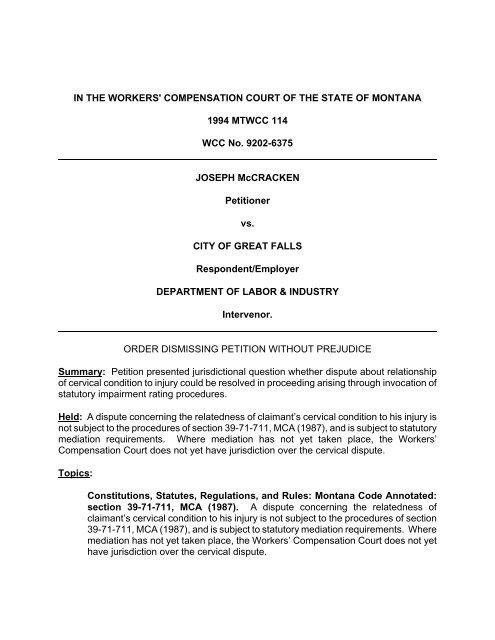
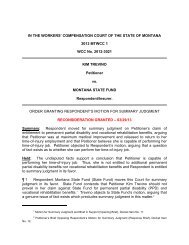
![Bustell v. AIG Claims Service, Inc. [05/03/05] 2005 MTWCC 23](https://img.yumpu.com/49777654/1/190x245/bustell-v-aig-claims-service-inc-05-03-05-2005-mtwcc-23.jpg?quality=85)
![Vallance v. MCCF [07/05/06] 2006 MTWCC 26 - Workers ...](https://img.yumpu.com/48724322/1/190x245/vallance-v-mccf-07-05-06-2006-mtwcc-26-workers-.jpg?quality=85)
